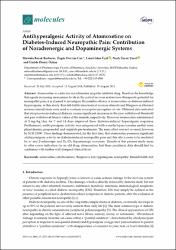Antihyperalgesic Activity of Atomoxetine on Diabetes-Induced Neuropathic Pain: Contribution of Noradrenergic and Dopaminergic Systems

Göster/
Erişim
info:eu-repo/semantics/openAccessTarih
2018Yazar
Barbaros, Mustafa BurakCan, Özgür Devrim
Ucel, Umut İrfan
Yücel, Nazlı Turan
Özkay, Ümide Demir
Üst veri
Tüm öğe kaydını gösterÖzet
Atomoxetine is a selective noradrenaline reuptake inhibitor drug. Based on the knowledge that agents increasing monoamine levels in the central nervous system have therapeutic potential for neuropathic pain, it is planned to investigate the possible efficacy of atomoxetine on diabetes-induced hyperalgesia, in this study. Randall-Selitto (mechanical noxious stimuli) and Hargreaves (thermal noxious stimuli) tests were used to evaluate nociceptive perception of rats. Obtained data indicated that streptozotocin-induced diabetes causes significant decreases in the paw withdrawal threshold and paw withdrawal latency values of the animals, respectively. However, atomoxetine administered at 3 mg/kg/day for 7 and 14 days improved these diabetes-induced hyperalgesia responses. Furthermore, antihyperalgesic activity was antagonized with -methyl-para-tyrosine methyl ester, phentolamine, propranolol, and sulpiride pre-treatments. The same effect was not reversed, however, by SCH 23390. These findings demonstrated, for the first time, that atomoxetine possesses significant antihyperalgesic activity on diabetes-induced neuropathic pain and this effect seems to be mediated by - and -adrenergic and D-2/D-3 dopaminergic receptors. Results of this present study seem to offer a new indication for an old drug; atomoxetine, but these preclinical data should first be confirmed with further well-designed clinical trials.

















